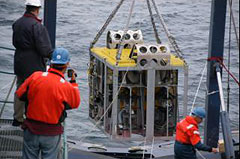

 | |||||||||||||
|
|
Journals 2007/2008Kathy Couchon
May 29, 2007 Latitude/Longitude: 74°16' N, 19° 44.7' E This was the first full day at sea on Oden and it began very early for me. I was up at 6 am to meet with the AUV team to review the preparations for deployment when we arrive at the test site. The vehicles are stored on the aft deck and there are still many tasks to perform before they can be sent into the water. For the cruise I have been assigned to work on the AUV team, testing the new autonomous vehicles, PUMA and JAGUAR. These vehicles, developed at WHOI, are equipped with an array of equipment including:
Today's test, however, was not for AUVs, but the wireline system, CAMPER, instead. CAMPER is a sled system designed to function as a camera/sampling instrument. It will survey the water column, taking both digital still and video pictures and is capable of sampling both biological organisms and sediments from the seafloor. We made our first transit stop off the Norwegian island of Bjørnøya, "Bear Island," to deploy CAMPER and test its systems. When not in use, CAMPER is stored under a tent on the afterdeck. Deploying this sled system is a time-intensive challenge as the tent must first be lifted off and set aside on the deck, and then CAMPER must be lifted by ship's crane to the aft deck where it is then attached to an A-frame winch and carefully lowered into the water. It seemed that everyone not involved in the deployment was on the upper decks filming the operation. Once this lengthy procedure ended, we were back on course, transiting to Test Site 1, within the ice pack. It is expected that we will meet the ice edge sometime late Wednesday. Though this is my second excursion into the Arctic ice pack, I am still excited to revisit this surreal environment. Will it be as exciting as I remember it being the first time? With that question in mind, I decide to catch some shut-eye until "ice time day".
|
||||||||||||

